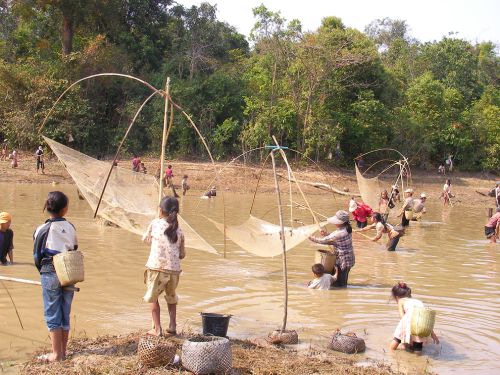What are culture-based fisheries?
18 April 2017 | 7755 views | Culture-based fisheries, Freshwater finfish, Inland aquaculture, Environment and Sustainability

Culture-based fisheries (CBF) are often conducted in small water bodies, perennial and or seasonal, that retain water for at least six to eight months of the year. CBF are stock enhancement practices in water bodies that are generally incapable of supporting sustainable fisheries through self-recruiting fish populations, and where the stock is managed and owned, either individually and or collectively.
- In CBF the natural productivity is utilised by the stocked seed, and rarely are external nutrients added to the system and or provided in the way of food for the stocked fish species. An exception may be when grass carp is stocked.
- Often the water bodies in which CBF is practised are communally managed by village organisations that are responsible for managing the water regime, such as for downstream cultivation. However, in some countries water bodies may be auctioned for CBF purposes by the authorities to an individual and or groups of individuals.
Increasingly, however, CBF are being practised in larger water bodies and through a strict co-management regime, with restricted access to the fish resources, for example large reservoirs stocked and fished by licensed members of a registered fishers' organisation with a concession to utilise a reservoir. Although there have been fisheries based on natural recruitment in these water bodies, adoption of planned stocking programs, together with the strict enforcement of a regime of co-management where only members of the relevant management unit are permitted to access the resource, essentially makes these a form of widening CBF practices.
It should also be noted that addition of seed stock to a water body with a view to enhancing fish production is only one facet of stock enhancement (SE). SE may also include other practices, such as introduction of close seasons, gear restrictions, establishment of conservation zones, improving and or establishing spawning grounds, removing impediments to spawning and other migratory pathways.
Species selection in culture-based fisheries
The spectrum of species used in CBF practices differ between regions within a country and between countries, often being dictated by the indigenous fish fauna of the country, the availability of suitable indigenous fish species for CBF practices (e.g. fast growing), fry and fingerling availability, consumer acceptance, among others. However, as the fish are generally left to forage on natural food supplies, species that are low in the food chain (herbivorous or omnivorous) are the most suitable.
On the other hand, in some countries alien species that have been established and have been used for aquaculture (intensive) purposes for a significant length of time, and which have not shown any explicit evidence of impacting biodiversity, continue to be used for CBF.
In all instances the choice of alien species for CBF practices have to be within the realm of the fishery/ biodiversity laws and regulations of the country.
Irrespective of whether indigenous or alien species are used in CBF practices, these practices offer a greater potential that stocked fish mingle with wild populations and so care should be taken to ensure/ minimise loss of genetic diversity of the respective wild counterparts through a well-planned broodstock management strategy.
CBF planning and integration with agriculture
As CBF is usually conducted as a secondary use of a water body, stocking and harvesting must also be planned around other uses of the resource, such as seasonal draw-down of water for crop irrigation.CBF practices are almost entirely dependent on the prevailing weather patterns, particularly those conducted in non-perennial, small water bodies, which also happens to be the where the bulk of current practices are conducted. As such, the potential impacts of climate change in relation to onset of the rainy periods and increased frequencies of prolonged dry and or rainy periods could impact on the production cycle.
Careful planning will be needed to ensure fry/ fingerling availability in accordance with changing weather patterns, where relevant, and also continued vigilance to ensure the safety of the stocked seed.
Since the CBF cycle follows the prevailing weather pattern within a given region/locality, the harvesting tends to occur within a narrow time frame. As CBF practices become more prevalent this could lead to an oversupply of fish within this narrow time frame resulting in poor returns to the practitioners/ community management units.
- To overcome the above the management groups within a region/locality have to liaise with each other and spread the harvesting as much as possible to avoid an oversupply.
- In addition, the CBF practicing communities need to explore the possibilities of adopting simple, least energy costing, processing techniques for selected species in order to maintain reasonable farm gate prices.
As CBF practices become increasingly popular, there will be a corresponding increase in the demand on seed stock, particularly advanced fry and or fingerling of desired species.
- Certain CBF practitioners have already become alert to the fact that the most desired seed stock size is fingerlings and have utilised the water body to rear hatchery purchased fry to advanced fry and or fingerlings in improvised hapas, thereby reducing the purchase price of seed stock and also reducing the overall mortality to grow out.
- Such practices should be encouraged to reduce constraints on fingerling supplies.
- In addition, as had happened in certain countries (e.g. Sri Lanka), fry to fingerling rearing as an auxiliary sector should be encouraged when constraints on fingerling supplies are minimised and also provides additional livelihood opportunities to rural communities.
Creative Commons Attribution.